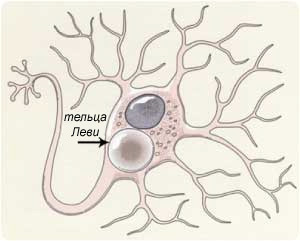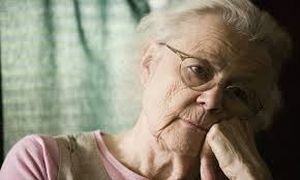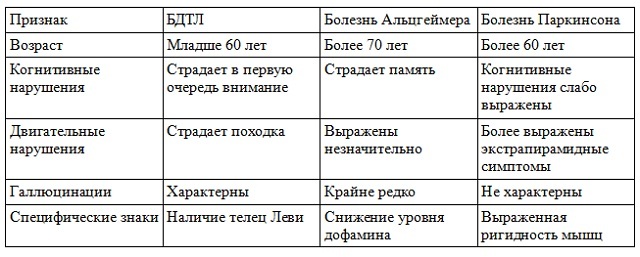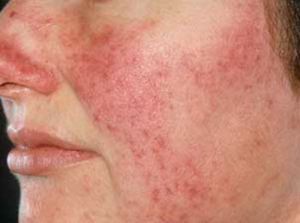 Dementia is a common concept that unites all disorders of cognitive functions.
Dementia is a common concept that unites all disorders of cognitive functions.
One of the variants of such disorders is Dementia with Levy bodies or Diseases of Levy diffuse bodies( BDTL).This disease of the nervous system - and specifically the cortex of the brain and subcortical structures.
Histological examination reveals specific inclusions in the brain tissues - the Lewi body. In the norm they should not be in a person young and middle-aged. The elderly are allowed a small amount. In their origin they are fragments of a disintegrated nerve cell - intracellular structures.
As an independent disease, this type of dementia was described in 1984 when studying the brain tissue of patients with alzheimer-like dementia. When studying the history of the disease and features of the symptoms, it was found that the disease has a number of differences from already known variants of dementia.
Content
- What happens in the body
- clinical picture
- Cognitive
- function hallucinatory syndrome
- Violation of motor function
- Sleep disturbance
- Vegetative disorders
- What is the difference from other types of dementia
- How is it diagnosed - criteria
- Medical assistance
What happens in
body Apartspecific Levi corpuscles in the brain substance found pathological protein amyloid - in 30% of cases. Possible  cause of BDTL is considered heredity - it was suggested on the basis of observations of family members of one of the patients. There is also a decrease in dopamine levels - similar to what happens in Alzheimer's disease.
cause of BDTL is considered heredity - it was suggested on the basis of observations of family members of one of the patients. There is also a decrease in dopamine levels - similar to what happens in Alzheimer's disease.
At a microscopic examination of the brain, its pronounced atrophy, smoothing of the cortical furrows is revealed. Specific Levi bodies, amyloid and cholesterol plaques are identified.
The most affected are the stem subcortical structures - they significantly reduce the number of neurons. There is also found the largest number of Lewy bodies - fragments of destroyed cells. These bodies consist of proteins, ubiquitin, the remains of cytoplasmic structures - the skeleton of the cell.
Clinical picture
The whole complex of symptoms associated with dementia with Levy bodies( dlb in the English-language literature) consists of several syndromes. In each of them, there are certain differences from other variants of dementia.
Cognitive functions
This is the most pronounced syndrome. In other types of dementia, memorization and speech function suffer first of all. At DDTL, the violation of concentration of attention is more pronounced. It manifests itself by quick fatigue, the inability to concentrate for a long time on any one occupation. Impossible becomes mental stress.
Because of this, rational thinking also suffers. The patient can not make up his daily routine, forgets about the things that he needs to do. Characteristic is the symptom of perserveration - the repetition of the same occupation a large number of times. Such a symptom is often found in psychiatric practice.
Hallucinatory Syndrome
 Another syndrome, more characteristic of psychiatry and almost not occurring in other types of dementia. Hallucinations in patients with BDTL are visual in nature. They do not appear immediately after the onset of the disease. All begins with visual impairment in the form of its decline.
Another syndrome, more characteristic of psychiatry and almost not occurring in other types of dementia. Hallucinations in patients with BDTL are visual in nature. They do not appear immediately after the onset of the disease. All begins with visual impairment in the form of its decline.
Then there are visual illusions, which later turn into full-fledged hallucinations. They usually take the form of people - familiar or unfamiliar to the patient. A person can talk to them, take some kind of action.
The hallucinatory syndrome is accompanied by the appearance of delusional ideas. Most often they are paranoid in nature.
Motor dysfunction
In the early stages of the disease of diffuse bodies of Levi appears such a symptom as parkinsonism. For other types of dementia, it is not characteristic, therefore at early stages the diagnosis of Parkinson's disease can be mistakenly diagnosed.
These disorders look like this:
- hypertension of the muscles of the limbs, leading to their rigidity;
- tremor of varying severity;
- is typical for other types of dementia, especially senile, shuffling gait, wiggle and walking uncertainty;
- frequent falls, sometimes on level ground.
Sleep disorder
It is the patient's nightmares. It is characteristic that the patient perceives them absolutely realistically. As a result, nightmares aggravate his condition. Under the influence of nightmares, a person commits active movements in a dream, which can lead to his fall from the bed.
Vegetative disorders of
They are observed only in a part of patients:
- depression of pressure when changing body position or after eating;
- urinary incontinence;
- violation of fast sleep phase.
What are the differences from other types of dementia?
Dementia is a progressive decline in cognitive functions, that is, the patient's condition worsens over time. BDTL has  characteristic differences, which made it possible to separate it as a separate disease.
characteristic differences, which made it possible to separate it as a separate disease.
Disturbance of cognitive functions has an oscillating character - that is, the patient's condition can then worsen, then improve. This phenomenon is called fluctuations in symptoms.
Consciousness fluctuations can be observed within one day or with a large interval of time. It depends on the general condition of the patient, the presence of chronic diseases, infections, other pathologies of the nervous system.
How the disease is diagnosed -
criteria To date, Lewy bodies in the brain can only be found by histological examination - that is, posthumously. During the life of the patient, the diagnosis is only "likely" or "possible".There are three criteria for setting such a diagnosis:
- a noticeable fluctuation in the intensity of cognitive impairment;
- presence of pronounced visual hallucinations;
- is an unfounded parkinsonism.
Possible PDTL is given if the patient has dementia and one of these criteria. Probable PDTL can be supplied only if all three criteria are present simultaneously.
There are additional criteria that allow more accurate diagnosis of an intravital diagnosis:
- frequent falls;
- periodic loss of consciousness;
- hypersensitivity and intolerance to drugs from the group of neuroleptics;
- visual illusions.
There is no specific instrumental diagnosis. The diagnosis is made only on the basis of clinical symptoms. Instrumental diagnosis is carried out for differential purposes - to exclude other brain lesions.
Various tests for short-term and long-term memory, speech and cognitive function are used to determine the extent of violations. It is important to interview family members or carers for the patient - about his behavior, about the violation of sleep, the presence of hallucinations and delusions.
Differential diagnosis is primarily carried out with Parkinson's and Alzheimer's disease. Criteria for the diffodiagnostics are given in the table:

Medical care
Since the pathogenesis of the disease lies in the death and decay of neurons, effective treatment does not exist. All methods are aimed only at slowing down this process, but not stopping it. Therapy is primarily aimed at the syndrome, which manifests itself in the most severe way.
The complexity of treatment is that drugs to eliminate one symptom can aggravate the course of another. This is the case with preparations for the treatment of Parkinsonism - they exacerbate the course of hallucinatory syndrome.
 The main group of drugs for the treatment of disease of diffuse Lewy bodies is cholinesterase inhibitors. Usually, the drug Exelon( Rivastigmine), which is an inhibitor of cholinesterase in the brain, is used, which causes a slowdown in the destruction of acetylcholine, the main synaptic mediator. This improves the conduct of the nerve impulse.
The main group of drugs for the treatment of disease of diffuse Lewy bodies is cholinesterase inhibitors. Usually, the drug Exelon( Rivastigmine), which is an inhibitor of cholinesterase in the brain, is used, which causes a slowdown in the destruction of acetylcholine, the main synaptic mediator. This improves the conduct of the nerve impulse.
The drug Akatinol Memantine is also used - a specific treatment for dementia. Memantine, the active component of the drug, is an antagonist of NMDA receptors. It is able to improve the transfer of momentum between neurons of the brain, as a consequence - to improve cognitive function.
The treatment of hallucinatory syndrome requires the appointment of neuroleptics. However, BDTL is characterized by poor tolerability of drugs of this group. Treatment begins with the most optimal drug - clozapine, and with minimal dosages.
Antidepressants and anticonvulsants are also used.
From non-drug therapies the following is used:
- psychotherapy;
- physiotherapy - massage, electrosleep;
- art therapy, music therapy;
- physiotherapy exercises.
Proper care of the patient is of no small importance. It is necessary to remove traumatic objects from the area of its accessibility. It is important to create a quiet environment in the family, as patients with BDTL are easily irritated and they may experience paranoid delusions.
A characteristic feature of Dementia with Levi bodies is its very rapid progression, from the onset of the disease to severe cognitive and motor impairment, an average of five years, and an average life span of about eight years.
Lethal outcome does not come from the most dementia, but from concomitant somatic diseases. Preventive measures have not been developed, because the cause of this disease is unknown.



